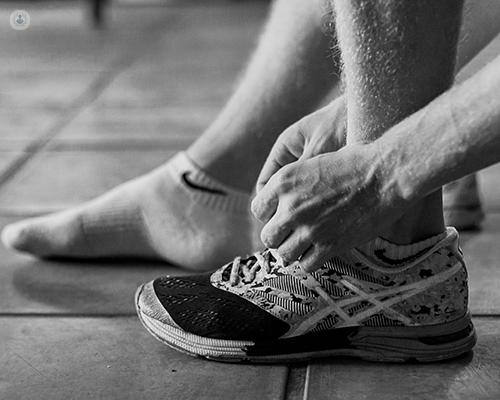Extensor tendonitis: how does it occur and how is it treated?
Escrito por:What is extensor tendonitis?
Extensor tendons are found at the top of the foot and over the ankle. They are often involved in extending your foot and ankle off the ground.
The term tendonitis suggests that this is inflammation of the tendons. However, this is misleading because it is not an agreement yet as to determine if the injury is inflammation or if it is re-generation of the tissue. Re-generation signifies damage to the tissue.

How does it occur?
Extensor tendonitis is essentially an overuse or repeated injury of the tendon.
Extensor tendonitis can develop from having little rest between activities, meaning that your body does not have time to heal and recover. It can also occur due to a sudden increase in load.
The injury can also be related to having badly fitted shoes, not having appropriate shoes when doing activities or a possible change in normal activities. This means that changing environment or conditions can increase the risk of suffering from extensor tendonitis.
How do you know if you have extensor tendonitis?
If there is pain on the top of your foot, this is a key indicator tbat you have extensor tendonitis.
The pain may be associated with swelling or discomfort when walking, as well as swelling going up your leg.
Some people describe the pain as a dull ache which can be aggravated with exercise. The key things that patients notice are a change in the function of the foot and difficulty in raising the foot off the ground.
Additionally, pain may be present when the foot is pushed down with certain activities such as cycling or rock climbing.
How is extensor tendonitis treated?
As with any soft tissue injury, the intial management should implement the RICE method—rest, ice, compression, and elevation. Patients should rest for short periods of times and allow the body to heal.
Healing may also be augumented with shockwave therapy, acupuncture or ultrasound therapy to help with the swelling and allow things to resolve.
Once the intial stage has passed, rehabilitation will be considered. Rehabilitation is often a triphasic approach, which considers all the different methods of muscle activation to try and help to improve the injury. It also aims to strengthen the foot so that extensor tendonitis does not re-develop at a laer stage.
Doctors also need to look at the underlying cause, to determine if the issue is with your training techniques, equipment or footwear. They must look at the causative factors to avoid this happening again.
The most important factor is that it should be a stage return and you should not rush back to doing things too quickly.
You have to listen to your voice and do things in a step wise process and build yourself up to pre-injury level. If you go back to activity too quickly you will go back several steps in development.
What happens if it goes untreated?
With extensive tendonitis in an acute phase, surgery is very rarely required.
As previously mentioned, treatment involves a lot of resting, elevation, having some rehabilitation and letting things settle.
However, if it is left untreated, it can lead to chronic tendonitis or tendiopathy, when you do get damage with your tendons.
There is a significant thickening and dysfunction of the tendons and you have noticed this on a day-to-day basis, not just about exercise.
This then leads to potential for rupture, which is when doctors begin to consider surgery. It is important to avoid this and avoid the alteration function, which is to follow the inacute phase, the initial management techniques.
If it gets to this stage, when you need to consider the surgery, you need to see a phonotical surgeon, to discuss the treatment options.


